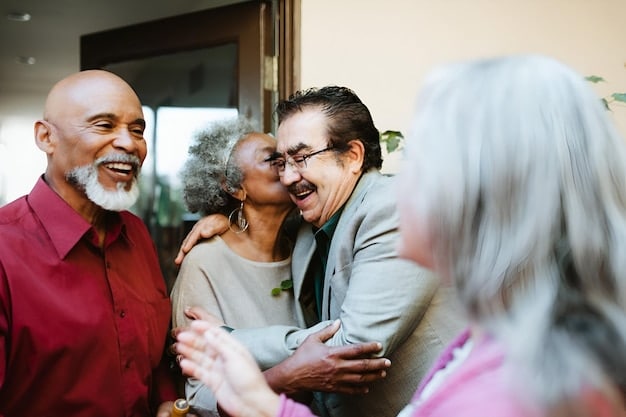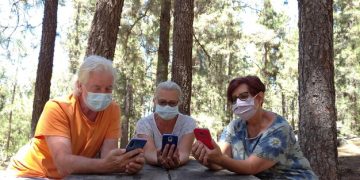Social Connection Enhances Senior Longevity & Well-being: New Research

New research underscores the critical role of social connection in significantly improving both the longevity and overall well-being of seniors, highlighting the profound impact of robust social networks on their health outcomes.
In an increasingly interconnected yet paradoxically isolated world, the profound influence of human connection on health and longevity is becoming undeniable. Recent studies shed new light on how social bonds are not just pleasantries, but vital components of a fulfilling and healthier later life, fundamentally shaping senior well-being.
The Intertwined Nature of Social Connection and Senior Health
The concept that “no man is an island” resonates deeply when exploring the health of older adults. For years, medical science has focused predominantly on physiological factors and genetic predispositions when discussing longevity. However, a growing body of evidence, culminating in New Research: The Impact of Social Connection on Senior Longevity and Well-being, reveals a powerful, often underestimated, determinant: social connection.
This evolving understanding emphasizes that our social fabric extends far beyond mere companionship; it is an intricate web supporting emotional regulation, cognitive function, and even immune response. Isolation, conversely, presents a significant health risk, comparable to smoking or obesity in its detrimental effects. It’s a silent epidemic affecting millions of older adults, quietly undermining their health and diminishing their quality of life.
Understanding the Biological Pathways
How exactly does social connection translate into quantifiable health benefits? The mechanisms are complex and multifaceted, involving both psychological and physiological pathways. Engagement in meaningful social interactions can lead to reduced chronic stress, a known precursor to numerous age-related diseases. When individuals feel connected, their bodies produce lower levels of stress hormones like cortisol, which, in excess, can damage cardiovascular health and suppress the immune system.
- Reduced inflammation markers, often associated with chronic diseases.
- Improved cardiovascular health due to lower blood pressure and heart rate.
- Enhanced immune system function, leading to better resistance to illness.
Furthermore, social engagement encourages healthier lifestyle choices. Individuals who are part of a supportive network are more likely to engage in physical activity, maintain a balanced diet, and seek timely medical care. This collective push towards wellness creates a positive feedback loop, reinforcing healthy behaviors and mitigating the risks associated with a sedentary or isolated lifestyle. The implications for public health initiatives aimed at senior populations are profound, shifting the focus from purely medical interventions to a more holistic approach that values community and belonging.
The expertise of gerontologists and social scientists is increasingly converging, recognizing that health outcomes in later life are not solely determined by individual choices or genetics, but are profoundly shaped by the environments and relationships we cultivate. This integration of sociological perspectives into health research is revolutionizing our understanding of what it means to age well, highlighting the critical need for proactive strategies that foster social bonds.

Longevity’s Social Secret: Data-Driven Insights
The scientific community has meticulously gathered data over decades, meticulously tracking cohorts of seniors to understand the variables influencing their lifespan. Initially, many studies focused on diet, exercise, and genetics. While undeniably important, these factors alone couldn’t fully explain the disparities in longevity observed across different populations. The missing piece, as emerging research strongly suggests, is social integration.
Recent landmark studies, employing sophisticated statistical models and large datasets, consistently demonstrate a clear correlation between the strength of an individual’s social network and their extended lifespan. These are not merely observations of cause and effect, but robust statistical correlations that account for other confounding variables. For instance, data from long-term studies like the Harvard Study of Adult Development, now spanning over 80 years, has consistently pointed to the quality of relationships as a stronger predictor of long and happy lives than wealth, fame, or even IQ. While this study focuses on a broader population, its findings are highly relevant to senior well-being.
Quantifying the Connection: Statistical Evidence
Specific findings from epidemiological studies paint a compelling picture. One meta-analysis, reviewing data from over 3 million individuals, found that strong social relationships were associated with a 50% increased likelihood of survival, comparable to quitting smoking and exceeding the benefits of exercise or absence of obesity. These statistics are not abstract numbers; they represent real lives extended and improved.
- Individuals with weak social ties faced a significantly higher risk of premature mortality.
- Marital status, family contact, and community involvement all contributed to increased longevity.
- The quality of social ties, not just the quantity, was a significant factor.
Furthermore, the data suggests that the protective effects of social connection are not limited to one particular type of relationship. Whether it’s close family bonds, friendships, community group participation, or even interactions with casual acquaintances, each layer of social engagement contributes to a cumulative benefit. The breadth and depth of a senior’s social interactions appear to create a resilient buffer against the stressors of aging, promoting both physical and mental fortitude. These insights are transforming the conversation around aging, pushing beyond conventional medical parameters to embrace a more holistic view of health determinants.
The ongoing collection of such robust data allows researchers to identify specific trends and establish clearer guidelines for interventions. It moves the discussion from anecdotal evidence to scientifically validated conclusions, providing a strong foundation for policies and programs aimed at enhancing senior health. This empirical rigor underscores the unwavering importance of fostering social connections as a cornerstone of public health strategy.
Combating the Silent Epidemic: Social Isolation and Loneliness
While social connection offers profound benefits, its inverse—social isolation and loneliness—poses significant threats to senior health. These terms are often used interchangeably, but they represent distinct phenomena. Social isolation refers to an objective lack of social contact, while loneliness is the subjective feeling of being alone or disconnected. Both, however, lead to similar detrimental health outcomes, often exacerbating each other.
The consequences of prolonged social isolation and chronic loneliness among seniors are alarming. They include an increased risk of depression, anxiety, dementia, heart disease, and premature death. The body reacts to the stress of loneliness by activating the fight-or-flight response, leading to chronic inflammation and a weakened immune system. This constant state of physiological alert takes a heavy toll on an aging body, accelerating the decline associated with natural aging processes.
Identifying Risk Factors and Vulnerable Populations
Several factors can increase a senior’s risk of isolation and loneliness. These include living alone, loss of a spouse or close friends, chronic health conditions that limit mobility, sensory impairments (such as hearing or vision loss), retirement, and geographical distance from family. Economic disadvantage can also limit access to social activities and transportation, further isolating individuals.
- Lack of access to transportation or community resources.
- Pre-existing mental health conditions, such as depression.
- Cultural or language barriers that hinder participation.
Addressing this silent epidemic requires a multi-pronged approach, involving direct intervention, community-level programs, and policy changes. Recognizing the signs of isolation and loneliness is the first step toward effective support. These signs might include a reluctance to leave the house, a decrease in communication, neglect of personal care, or a general lack of enthusiasm for previously enjoyed activities. Family members, caregivers, and healthcare providers all play a crucial role in identifying and responding to these indicators, initiating conversations that can pave the way for reconnection.
The profound impact of these conditions necessitates immediate and thoughtful action. Without robust social networks, seniors are left vulnerable to myriad physical and psychological detriments. It is imperative that healthcare systems, community organizations, and individual families work in concert to build bridges that connect isolated seniors to their communities, ensuring that feeling alone does not equate to being alone. Early intervention can prevent a cascade of negative health effects.
Practical Strategies for Fostering Connection in Later Life
Given the undeniable benefits of social connection, the critical question becomes: how can we proactively foster these vital bonds in later life? The answer lies in a combination of individual effort, familial support, and community-level initiatives. It requires a shift in perspective, viewing social engagement not as a luxury, but as a fundamental aspect of elder care and public health.
For individuals, simple yet powerful actions can make a significant difference. Reaching out to old friends, joining a local club or volunteer group, or simply striking up conversations with neighbors can be transformative. The key is seeking out opportunities for regular, meaningful interaction. Technology also offers new avenues for connection, allowing seniors to connect with family and friends remotely, participate in online communities, or even take virtual classes.
Community-Based Solutions and Programs
Communities and organizations play a pivotal role in creating environments that facilitate social engagement. Senior centers, libraries, and parks often host programs specifically designed for older adults, ranging from exercise classes to book clubs and crafting groups. These spaces provide neutral ground for interactions and opportunities to develop shared interests.
- Volunteer opportunities that match seniors with causes they care about.
- Intergenerational programs that connect seniors with younger generations.
- Support groups for shared experiences, like bereavement or chronic illness.
Furthermore, healthcare providers can integrate social prescribing into their practices, advising patients on local social activities and resources that could benefit their well-being. This innovative approach recognizes that health extends beyond the confines of a doctor’s office, acknowledging the crucial role of social determinants. Transportation solutions, accessible venues, and inclusive program designs are also essential to ensure that all seniors, regardless of their physical or economic limitations, can participate fully in community life.
The collective effort to build more socially integrated communities for seniors is an investment in their health, happiness, and dignity. It acknowledges that human connection is a fundamental need, not merely a preference. By fostering an environment where seniors feel valued, supported, and connected, we not only improve their individual lives but also enrich the fabric of society as a whole, creating more resilient and compassionate communities for everyone.
The Future of Senior Care: A Holistic and Connected Model
The insights derived from New Research: The Impact of Social Connection on Senior Longevity and Well-being are poised to revolutionize the landscape of senior care. Traditionally, senior care has often been compartmentalized, focusing on medical treatments, physical therapy, and basic needs. While these aspects remain crucial, the growing recognition of social connection’s profound influence demands a more integrated, holistic approach.
The future of senior care envisions models that actively weave social engagement into the very fabric of daily life. This means moving beyond occasional social gatherings to creating environments where meaningful interaction is the norm, not the exception. Assisted living facilities, nursing homes, and home care services are beginning to explore innovative ways to foster community and combat isolation, from communal dining experiences to technology-assisted communication platforms.
Integrating Social Connection into Policy and Practice
Policy makers, healthcare systems, and non-profit organizations are increasingly recognizing the economic and social benefits of investing in social connection initiatives. Preventative measures that reduce loneliness can lead to lower healthcare costs, fewer hospital readmissions, and an overall healthier aging population. This shift in perspective views social health as a public good, worthy of dedicated resources and strategic planning.
- Funding for community centers and intergenerational programs.
- Incentives for developing age-friendly communities with accessible social spaces.
- Training for healthcare professionals on screening for and addressing social isolation.
The emphasis is also on empowering seniors themselves to take charge of their social lives. Providing resources, education, and accessible pathways to connection can help individuals build and maintain robust social networks throughout their later years. This empowers them to age with dignity and autonomy, remaining active and engaged members of their communities. The goal is to move from a reactive model of care, which responds to crises, to a proactive one that prevents them by building resilience.
As the global population ages, the imperative to create supportive and connected environments for seniors becomes ever more pressing. The research clearly indicates that the benefits extend beyond mere existence, contributing to a vibrant, purposeful, and profoundly human experience of aging. Embracing a holistic and connected model of senior care represents not just a best practice, but a moral imperative, ensuring that our elders thrive, rather than merely survive.

The Role of Technology in Bridging Social Gaps
In an era of rapid technological advancement, digital tools are emerging as powerful allies in the quest to enhance social connection among seniors. While often perceived as a barrier by older generations, technology, when appropriately deployed and supported, can effectively bridge geographical distances, overcome mobility limitations, and even connect individuals with shared interests they might never otherwise encounter.
Video calling platforms, social media groups, and online forums have become vital arteries for maintaining family ties and friendships, particularly for those with limited physical mobility or distant relatives. These tools allow seniors to see and hear their loved ones, bringing a sense of presence that traditional phone calls cannot replicate. Furthermore, specialized apps and devices designed with older users in mind offer simplified interfaces, making digital interaction more accessible and less daunting.
Digital Literacy and Accessible Design
However, the mere existence of technology is not enough. To truly leverage its potential, initiatives must focus on improving digital literacy among seniors and ensuring that technological solutions are designed with accessibility in mind. Training programs, often offered by libraries or community centers, can empower seniors with the skills and confidence to navigate the digital world safely and effectively.
- Workshops on using video chat and social media platforms.
- Programs that provide seniors with affordable internet access and devices.
- Creating user-friendly interfaces specifically tailored for older adults.
The potential for technology extends beyond personal communication. Online communities and interest groups provide platforms for seniors to connect with peers who share hobbies, experiences, or challenges, fostering new friendships and a sense of belonging. Virtual reality (VR) is also showing promising applications, offering immersive experiences that transport seniors to new places or allow them to “visit” distant relatives. These innovations can combat feelings of isolation by expanding their world beyond physical limitations.
While technology is undoubtedly a powerful tool, it should always be seen as a complement to, rather than a replacement for, face-to-face human interaction. The most effective strategies will likely involve a blended approach, using digital means to facilitate and supplement real-world connections. The objective remains the same: to create robust and meaningful social networks that support seniors in leading healthier, happier, and more connected lives, ensuring that technological advancements serve to augment, not detract from, authentic human relationships. The ongoing development of user-centric technology is paramount for successful widespread adoption and sustained benefit.
Empowering Seniors: Self-Advocacy and Peer Support
While external support and community initiatives are vital, an equally crucial component in fostering social connection among seniors is empowering them to become self-advocates for their own well-being and to engage in peer-to-peer support. This approach recognizes the autonomy and agency of older adults, shifting the narrative from passive recipients of care to active participants in their social health journey.
Self-advocacy involves encouraging seniors to vocalize their needs, interests, and desire for connection. This might mean explicitly telling family members about feelings of loneliness, seeking out information on local clubs, or proposing new activities within their communities. It requires cultivating a sense of confidence and initiative, reminding seniors that their social lives are within their own sphere of influence. This can be particularly empowering for those who may have felt increasingly marginalized or dependent as they age.
The Power of Peer Networks
Peer support networks are immensely valuable. When seniors connect with others who share similar life experiences, they find understanding, empathy, and practical advice. These networks can range from informal gatherings of friends to structured support groups focused on specific issues like bereavement, chronic illness, or caregiving. The shared experience creates a powerful bond, reducing feelings of isolation and validating their struggles and triumphs.
- Mentorship programs where experienced seniors guide newer retirees.
- Online forums and chat groups moderated by peers.
- Local senior groups that organize social outings and activities.
Empowering seniors also means providing them with the tools and information to manage their own social calendars and seek out opportunities for engagement. This includes accessible information about local events, transportation options, and volunteer opportunities. Moreover, fostering an environment where seniors are encouraged to lead and organize their own activities can significantly enhance their sense of purpose and belonging. When they are at the helm, the activities naturally align with their authentic interests and preferences.
This emphasis on self-advocacy and peer support is a testament to the belief that seniors are not just beneficiaries of social connection, but active agents in its creation and maintenance. By nurturing their capacity to build and sustain their own social networks, we not only improve their individual well-being but also strengthen the collective fabric of elder communities, fostering resilience and mutual support. It’s about building a culture where seniors are empowered to live their most connected lives.
| Key Aspect | Brief Description |
|---|---|
| 🤝 Social Longevity Link | Strong social ties significantly increase lifespan, comparable to major health interventions. |
| 🔬 Biological Benefits | Connection reduces stress hormones, boosts immunity, and improves cardiovascular health. |
| 🛡️ Combating Isolation | Loneliness increases risks of depression, dementia, and premature death. |
| 📱 Tech Integration | Technology offers new ways to connect, complementing traditional social interactions. |
Frequently Asked Questions
The core finding confirms that robust social connections are not merely beneficial but are crucial determinants of senior longevity and overall well-being. Strong social ties significantly reduce the risk of premature mortality and improve various health outcomes across physical and mental domains, leading to a longer, healthier life.
Social connection positively influences biological markers by reducing chronic stress, lowering levels of cortisol, and decreasing inflammation. It also boosts immune system function and promotes better cardiovascular health by helping to regulate blood pressure and heart rate, thereby enhancing the body’s resilience.
Social isolation is an objective lack of contact, while loneliness is the subjective feeling of being alone. Both are harmful, increasing risks of depression, anxiety, dementia, heart disease, and premature death. They activate stress responses that weaken the immune system and lead to chronic inflammation in the body.
Seniors can actively join community groups, volunteer, engage in intergenerational programs, or seek out social clubs. Utilizing technology like video calls and online communities can also bridge distances. Even simple acts like reaching out to neighbors or old friends can significantly improve social engagement and well-being.
Technology provides new avenues for connection, enabling seniors to maintain ties through video calls and social media, join online interest groups, and access virtual reality experiences. While it complements face-to-face interaction, it offers crucial support for those with mobility limitations or distant family, expanding their social reach.
Conclusion
The robust findings from the latest research unequivocally underscore the profound and multifaceted impact of social connection on the longevity and holistic well-being of seniors. Moving beyond anecdotal observations, the scientific community now presents compelling evidence that human relationships are not merely supplemental to health but are foundational. As we look to the future of senior care, it’s clear that a truly effective approach must integrate social engagement as a central pillar, fostering environments where connection flourishes. This isn’t just about extending life, but enriching it, ensuring that our elder years are marked by vitality, purpose, and the irreplaceable warmth of human companionship.





